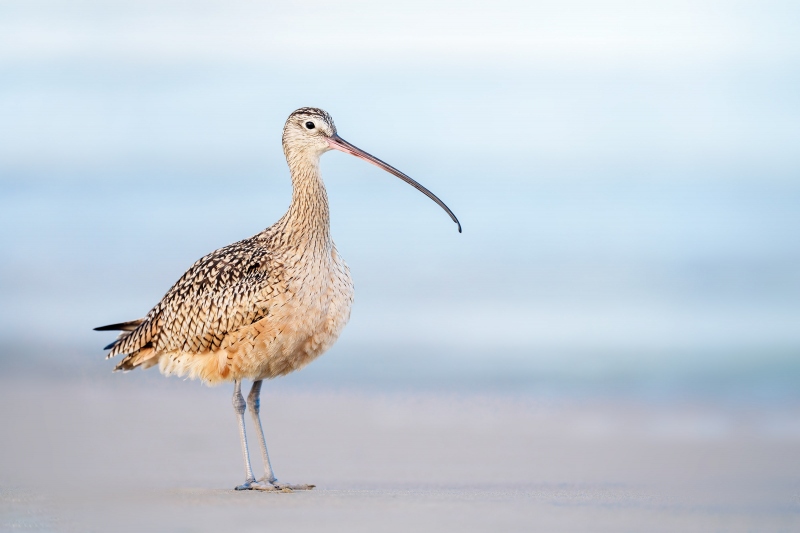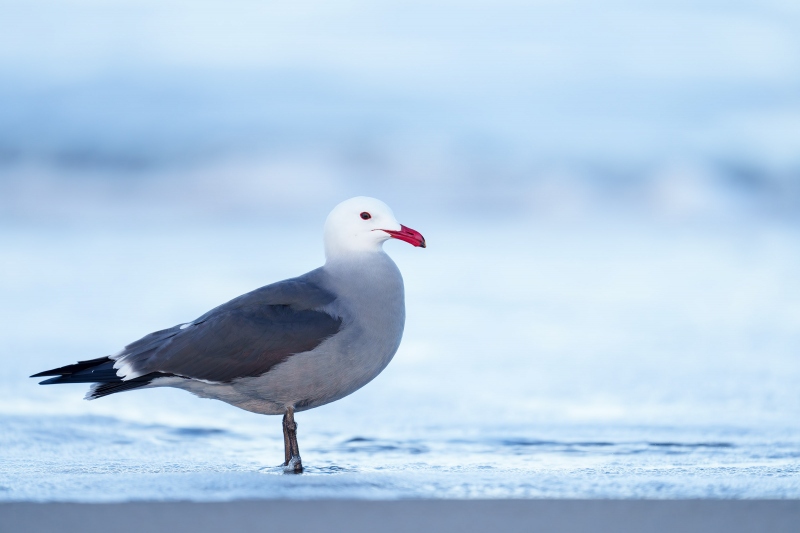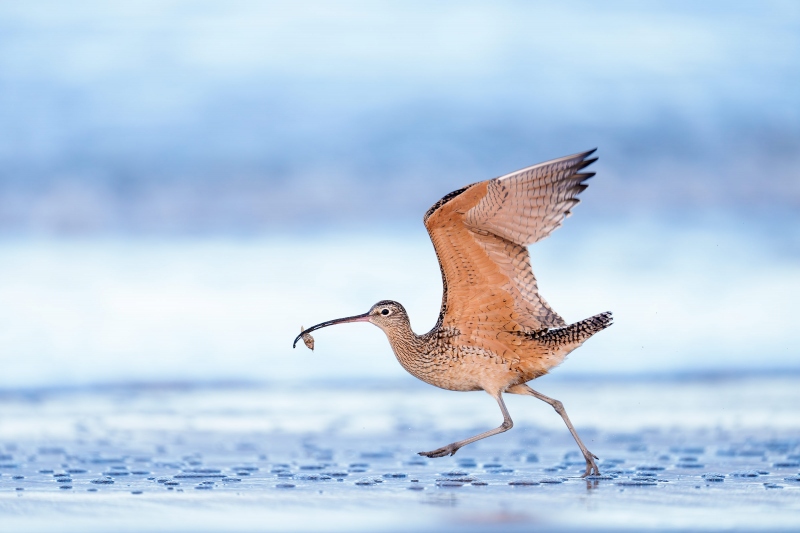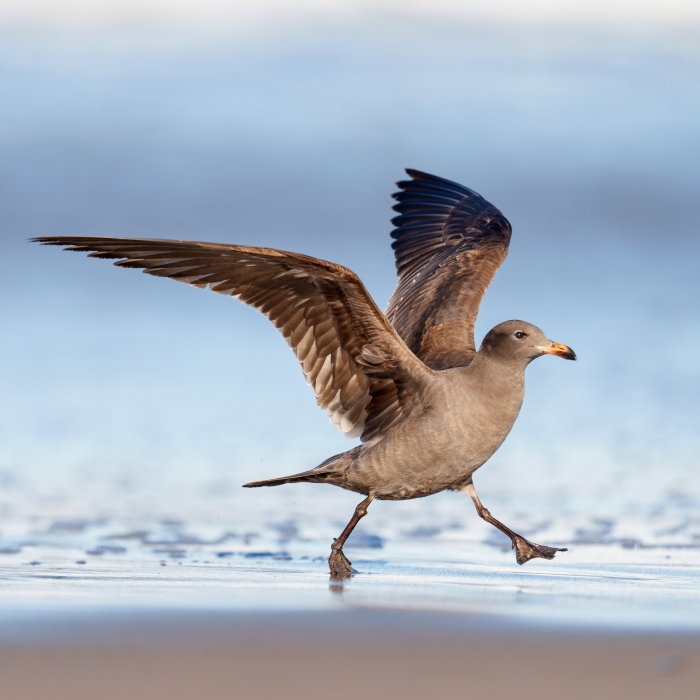Apologies
As I have had just one day off from teaching since I arrived in CA here weeks ago. I have fallen behind badly with regards to answering e-mails. As I fly home this coming Saturday, I should begin catching up early next week.
What’s Up?
As in San Diego, we have dodged lots of challenging weather on the Morro Bay IPT. But we have had many great chances and done well. Best of all, everyone is learning. As expected, the Long-billed Curlews have been the stars of the show. On Wednesday, there were several hundred Short-billed Gulls. On other days, just a few. This species was formerly named Mew Gull or Common Gull. It is best described as a miniature version of Ring-billed Gull with a tiny bill. The first winter birds are quite handsome.
And on Thursday evening we enjoyed a pretty sweet sunset.
Today is Friday 9 February 2024, the third full day of the IPT. We are again headed out early. Wherever you are and whatever you choose to do, I hope that you too have a great day.
Please remember to use the B&H links that are found on most blog pages and to use the BIRDSASART discount code at checkout when purchasing your new gear from Bedfords to get 3% back on your credit card and enjoy free second-day air FedEx. Please, also, consider joining a BAA IPT. You will be amazed at how much you will learn!
If an item — a Delkin flash card, or a tripod head — for example, that is available from B&H and/or Bedfords, is also available in the BAA Online Store, it would be great, and greatly appreciated, if you would opt to purchase from us. We will match any price. Please remember also to use my B&H affiliate links or to earn 3% cash back at Bedfords by using the BIRDSASART discount code at checkout for your major gear purchases. Doing either often earns you free guides and/or discounts. And always earns my great appreciation.
Go Chiefs.
My Call
In the last blog post, I loved both images but my favorite was the cormorant blur. The venerable Cliff Beittel agreed when he commented and summed up my thoughts precisely: The blur, perhaps because of the panning, is perfect. The vibrating x-ray-like sharpness in the primaries is amazing. Love the panned waves and color.
Your Call?
Which of today’s four featured Morro Bay images is the strongest? Which is the weakest? Why for both?
Swamped by a Rogue Wave
Sony a-1 Weather Sealing
Many complain about the weather sealing of the Sony a-1 against both moisture and grit. As I routinely abuse all three of my a-1 bodies, I never complain. I recently sent in my two oldest a-1 bodies for a clean and check. (Free including round-trip FedEx shipping for SONY ProSupport members — $100 annually.) Because of sand and corrosion, I was charged about $500 for each. Both bodies were restored to pretty much like new condition. I was happy.
Many know that I totaled and a-1 in San Diego two years ago by dropping an a-1 on the 200-600 into a foot deep tide pool while clambering around on the low cliffs at La Jolla (camera-end first). The lens was fine. The camera was insured.
On Wednesday morning, I was sitting on the beach at Morro Bay with my 2-6. I saw a rogue wave coming. I turned to my right and attempted to crawl away quickly on my knees and elbows. In a flash, I was swamped. I was aghast when I saw my rig disappear under the salt water for 2-3 seconds. I had a gallon of the ocean in my right hand parka pocket along with several ounces of sand. I was pretty sure that the body was toast, but was surprised that it did not go haywire. After a few minutes, the Thumb Dial quit responding followed soon thereafter by the Fn button. All else continued to work just fine. I had to turn off Display from My Menu and set the ISO off the menu item. That cost me a ton of time. But I still made some good images.
When we finished the morning session, I turned the camera off to close the shutter. When I got back to the AirBnB, I removed the battery, removed the front cover, opened the flash card door, and placed the camera and the lens in the far end of a pillow case. Then I positioned a hair dryer with the nozzle pointed into the pillow case, set it to low, and turned it on for an hour. Both the Thumb Dial and the Fn button worked perfectly.
Yes, there is the chance that the camera will succumb to corrosion from the salt at any time. After using it all day on Thursday, I was impressed that it is worked perfectly.
Had I simply raised the camera and faced the wave head on, the rig would have stayed dry and out of harm’s way. My mistake was thinking that I might escape unscathed.
Save 15%!
If you’d like to try out a new lens or if you need a lens for a specific trip or project (or for an IPT), LensRentals.com is the only way to go. To save 15%, simply click on the logo link above, arrange for your rental, and type in BIRDSASART15. If you type the gear you are looking for in the search box, it will pop right up. LensRentals.com offers affordable insurance. You can decline it, opt for LensCap: Damage Only, or select LensCap: Damage & Theft. Then hit PROCEED TO CHECKOUT. After you enter all of your info but before completing your order, be sure to scroll down to Promo Code box and enter the BIRDSASART15 code to save 15%.
I checked on renting a Sony FE 70-200mm f/2.8 GM OSS II lens for a week. The cost is only $122.00. LensCap: Damage Only coverage can be added for a very low $18.00. Going with LensCap: Damage & Theft would be $27.00. The shipping charge varies. They offer an interesting program called Lensrentals HD. By signing up for this shipping discount program ($99.00/year), you’ll get free Standard Shipping on all the orders you place.
Renting a Sony 600mm f/4 GM OSS lens for a week will cost you $536.00. The two coverage options come in at $76.00 or $114.00. Less your 15% discount when you enter the BIRDSASART15 code into the Promo Code box at checkout and enter the BIRDSASART15 codeine the Promo Code box at checkout to save 15%.
Remember, to save the 15% on your rental you must start your search by clicking on the logo above, or on this link: LensRentals.com


B&H
To ensure that I get credit for your B&H purchases, you can always click here. The tracking is invisible but greatly appreciated. And, you can use your PayBoo card. You must use the website to order. B&H will reopen on Fri April 14. Thanking me for the past 4000 educational blog posts could not be any easier and will not cost you one penny. Please shoot me your B&H receipt for major purchases.
Many folks have written recently stating that they purchased a Sony a1 from B&H and would like their free membership in the Sony 1 Info and Updates Group, a $150.00 value. When I check my affiliate account, their orders have not been there. When I let them know that they get credit for B&H purchases only if they use one of the many B&H affiliate links on the blog or begin their searches with this link, they are always disappointed. If in doubt, please contact me via e-mail and request a BH link. I am always glad to help and to guide you to the right gear.
Bedfords Simplified
Click here to start your search. Choose standard shipping, and when you get to the payment page, enter BIRDSASART in the discount code box and hit apply. You will be upgraded to free second day air Fed-Ex and receive 3% cash back on your credit card once your stuff ships. Either is greatly appreciated by yours truly.
Bedfords Amazing BAA Discount Policy
Folks who have fallen in love with Bedfords can now use the BIRDSASART coupon code at checkout to enjoy a post-purchase, 3% off-statement credit (excluding taxes and shipping charges) on orders paid with a credit card. The 3% credit will be refunded to the card you used for your purchase. Be sure, also, to check the box for free shipping to enjoy free Second Day Air Fed-Ex. This offer does not apply to purchases of Classes, Gift Cards, prior purchases.
Visit the Bedfords website here, shoot Steve Elkins an e-mail, or text him on his cell phone at (479) 381-2592.
Gear Questions and Advice
Too many folks attending BAA IPTs and dozens of photographers whom I see in the field and on BPN, are — out of ignorance — using the wrong gear, especially when it comes to tripods and more especially, tripod heads. And the same is true in spades when ordering new camera bodies or lenses. My advice will often save you some serious money and may help you avoid making a seriously bad choice. Please know that I am always glad to answer your gear questions via e-mail. If you are desperate, you can try me on my cell at 863-221-2372. Please leave a message and shoot me a text if I do not pick up.
|
|
|
This image was created on 6 February while photographing with Mike Lavigne who drove down from Seattle for a day of private instruction before the Morro Bay IPT. We had a great morning. Seated on damp sand behind my flattened Robus RC-5558 Vantage Series 3 Carbon Fiber Tripod topped by a Levered-Clamp FlexShooter Pro, I worked off the rear monitor with the the Sony FE 600mm f/4 GM OSS lens and The One, the Sony Alpha 1 Mirrorless Digital Camera.. The exposure was determined by Zebra technology with ISO on the Thumb Dial. ISO 2500: 1/1000 second at f/4. AWB at 7:49:40am on a then cloudy morning. Tracking: Expand Spot/AF-C with Bird-Eye/Face Detection performed perfectly. Click on the image to enjoy the high-res version. Image #1: Long-billed Curlew posing for portrait |
The Huge Advantage
Sitting behind your lowered tripod allows for much more intimate portraits than those created while standing at full height. Nothing, however, can match the intimacy of getting super-low by working off your flattened tripod (as I did with all of today’s images), by using the heel pod technique, or by placing the lens hood right on the ground. In general, the lower you go, the sweeter and more distant the background. Image #1 illustrates this perfectly. Working wide open eliminates any possible distracting lines in the background — the beach melts into the ocean and the ocean connects seamlessly with the sky.
|
|
|
This image was also created on 6 February while photographing with Mike Lavigne who drove down from Seattle for a day of private instruction before the Morro Bay IPT. We had a great morning. Seated on damp sand behind my flattened Robus RC-5558 Vantage Series 3 Carbon Fiber Tripod topped by a Levered-Clamp FlexShooter Pro, I worked off the rear monitor with the the Sony FE 600mm f/4 GM OSS lens and The One, the Sony Alpha 1 Mirrorless Digital Camera.. The exposure was determined by Zebra technology with ISO on the Thumb Dial. ISO 2000: 1/3200 second at f/4. AWB at 8:26:30am on a then still cloudy morning. Tracking: Expand Spot/AF-C with Bird-Eye/Face Detection performed perfectly. Click on the image to enjoy the high-res version. Image #2: Herman’s Gull adult breeding plumage |
Heermann’s Gull
There are a zillion Heermann’s Gulls in Morro Bay. Though most are juveniles and 2nd winter birds, there are more than enough breeding plumages adults around to make any bird photographer happy. If you are in love with the intimate super-low look, be sure to bring your reading glasses if you need them as they make it much easier to see the location of the AF point or points and to carefully frame each image.
The Levered-Clamp FlexShooter Pro is beyond compare when working super low. Once you firm the tripod into the sand, take a moment to level the silver ball and then lock the black lever. Then rotate the lens in the tripod collar to the click stop. When you activate the level you will note that your rig is perfectly square to the world no matter where you point the lens. You can pan left or right without ever having to worry about crooked horizon lines.
|
|
|
This image was also created on 6 February while photographing with Mike Lavigne who drove down from Seattle for a day of private instruction before the Morro Bay IPT. We had a great morning. Seated on damp sand behind my flattened Robus RC-5558 Vantage Series 3 Carbon Fiber Tripod topped by a Levered-Clamp FlexShooter Pro, I worked off the rear monitor with the the Sony FE 600mm f/4 GM OSS lens and The One, the Sony Alpha 1 Mirrorless Digital Camera.. The exposure was determined by Zebra technology with ISO on the Thumb Dial. ISO 1600: 1/2500 second at f/4. AWB at 8:27:42am on a then cloudy bright morning. Tracking: Zone/AF-C with Bird-Eye/Face Detection performed perfectly. Click on the image to enjoy the high-res version. Image #3: Long-billed Curlew escaping with Mole Crab |
Not Easy
Even with the smooth, level panning provided by the Levered-Clamp FlexShooter Pro, tracking and framing moving subjects is difficult when working super low. In Image #3, however, I was able to fire off six image when a gull began chasing this curlew in hopes of grabbing its crab. I was able to pan quickly enough so that the first four images were well framed. Three of the four featured very pleasing wing positions. With the last two images, I was unable to pan quickly enough and the bird’s long bill was clipped.
|
|
|
This image was also created on 6 February while photographing with Mike Lavigne who drove down from Seattle for a day of private instruction before the Morro Bay IPT. We had a great morning. Seated on damp sand behind my flattened Robus RC-5558 Vantage Series 3 Carbon Fiber Tripod topped by a Levered-Clamp FlexShooter Pro, I worked off the rear monitor with the the Sony FE 600mm f/4 GM OSS lens and The One, the Sony Alpha 1 Mirrorless Digital Camera.. The exposure was determined by Zebra technology with ISO on the Thumb Dial. ISO 640: 1/3200 second at f/4. AWB at 9:03:02am on a then partly sunny morning. Tracking: Zone/AF-C with Bird-Eye/Face Detection performed perfectly. Click on the image to enjoy the high-res version. Image #4: Herman’s Gull second winter plumage running |
Still Not Easy
As this second winter Heermann’s Gull began chasing a curlew, I did not pan quickly enough to keep the bird back in the frame. I tried several times to add canvas in front of the bird, but with the varying patterns in the water, I gave up and went to a square crop. Following moving subjects when working super-low is far more difficult than when working off your lowered tripod or when handholding (either seated or standing). What are you looking for, art or action? In Image #3 I was lucky enough to come up with both. Note that handholding is only an option if you are easily able to manage the weight of the lens you wish to use.
Typos
With all blog posts, feel free to e-mail or to leave a comment regarding any typos or errors.



















#1 & 3 are spectacular though I find the sharpening a bit excessive in #3 particularly in the bubbles. Also, I might have preferred a bit more foreground too. Great story and glad the gear is ok.
Your being swamped at La Jolla reminds me that many years ago at a color photography workshop at California’s Point Lobos State Reserve near Monterrey, a site known for rogue waves, the instructor, Helen C. Manzer of New York told students before we commenced tide pool work, “Never turn your back on the Pacific”. Helen was a Leica advocate, and getting one of those soaked in salt water was a total disaster.
For saltwater use there’s always the Nikonos.
#3 – love the water bubbles. crabs??
Love #1. The bottom of the bird being just above the water/sand intersection makes it.
I heard a story about a guide (a good friend of mine) in South Georgia who had a bunch of clients out in really severe weather. Many with gear other than Sonys (mostly Canon, 15 or so) had their cameras fail. The Sonys did not.